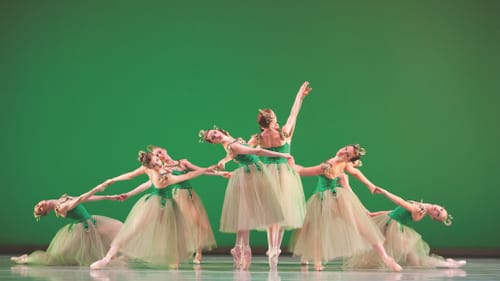Stay in the Loop
BSR publishes on a weekly schedule, with an email newsletter every Wednesday and Thursday morning. There’s no paywall, and subscribing is always free.
Pennsylvania Ballet puts a ring on it
Pennsylvania Ballet presents George Balanchine's 'Jewels'

Pennsylvania Ballet concludes its season with Jewels, by legendary choreographer George Balanchine. The full-length ballet began and ended with beautiful tableaux, as did each of its three parts, named for precious stones. Together with the elegant execution of intricate steps and combinations and some standout performances, Jewels' — and Pennsylvania Ballet's — grace and appeal were captured at their best.
Jewels is a wise choice for a company working through challenges, some of which are shared by other organizations as ballet endeavors to identify and connect with a 21st-century audience. But Pennsylvania Ballet has faced its own highly publicized trials, from the shakeups that followed Ángel Corella's appointment as artistic director to a biting review of Swan Lake in the New York Times earlier this season.
It was impossible to banish thoughts of the company’s struggles as I watched Jewels. Happily, it offers much to like, aside from the occasional misstep.
Three jewels, three moods
Unlike famous story ballets such as Swan Lake, Jewels has no plot. Reading the program notes helps one appreciate the dance’s parts as well as its whole. According to dance lore, a window display at Van Cleef & Arpels jewelers inspired Balanchine to create this ballet with three distinct sections: “Emeralds,” “Rubies,” and “Diamonds.” Each also has its own music, aesthetics, and mood: French Romanticism, American irreverence, and Russian formality.
“Emeralds” comes first to music by Gabriel Fauré, and its measured pace and leisurely pauses make it a strange opener. During intermission, I overheard someone compare it to beginning a Broadway show with a ballad.
“Emeralds” may be less accessible than the other sections, but it contained moments of pure grace. Kicks and turns made aesthetic use of tulle skirts by Karinska. Duets by Oksana Maslova with Ian Hussey and Mayara Pineiro with Arian Molina Soca, were full of lifts, balances, and arabesques that offset the shifting formations of the corps, who formed circles, lines, and geometric patterns.
Maslova shone in a solo, making fast footwork and sky-high kicks look effortlessly graceful. Nayara Lopes, Jacqueline Callahan, and Zecheng Liang formed a spirited trio, especially among Liang’s sky-high jumps and athletic batterie.
But slower parts in “Emeralds” make it the least exciting jewel, a fact compounded by a perplexing false ending. Balanchine inserted a tableau so much like the opener that “Emeralds” seems about to end. You applaud, ready for something new, but the dance continues. If this is a flaw, it is one of choreography rather than dancing.

Diamonds and romance
Set to music by Stravinsky, “Rubies” brings a welcome change of pace. Here, Balanchine incorporates casual, modern movements evoking jazzy energy and sensuality. Lillian DiPiazza, Jermel Johnson, and Alexandra Hughes skipped their feet while circling their wrists in motions that suggested jumping rope. Di Piazza and Hughes struck pin-up poses, with a hand on the hip and another behind the head. Groups of dancers pranced across the stage, female dancers executed body rolls, and hands bent suddenly at the wrist in a gesture reminiscent of Thriller zombies.
“Diamonds” concludes the program, and it is a return to form, marrying traditional ballet combinations with music by Tchaikovsky, a composer who created scores expressly for ballet and later inspired Balanchine. Perhaps for this reason, “Diamonds” feels the most classical and most familiar.
The stage filled with bodies in motion; at one point, 14 dancers performed together. This large group and their white Karinska costumes brought to mind the snowflakes in Nutcracker, another product of the Balanchine/Tchaikovsky partnership. Similarly, during a duet, when Sterling Baca kissed Dayesi Torriente’s hand and looked away, the moment captured the romance of story ballets.
Baca and Maslova were the evening’s brightest gems. But Jewels did not always shine: “Emeralds” was weakest technically, with dancers moving off tempo and breaking synchronicity several times. It also looked like some dancers were off mark, creating uneven spaces in lines and formations that should have been balanced. However, this could have been an illusion created by the view from my seat.
In “Rubies,” a few dancers struggled with exaggerated, circus-y balances. And I don’t enjoy that Pennsylvania Ballet performances typically start late and contain interminable intermissions (Jewels has two).
Overall, Jewels offers a fine performance and solid end to the season. Its final tableau leaves audiences with an image of beauty and elegance, and those recurring tableaux string together the three jewels. As different as the sections are, each reflects an aspect of its precious stone and contains choreography suggesting facets of cut gemstones and settings in which those stones can be mounted.
What, When, Where
Jewels. By George Balanchine. Through May 13, 2018, at the Academy of Music, 240 S. Broad Street, Philadelphia. (215) 893-1999 or paballet.org.
Sign up for our newsletter
All of the week's new articles, all in one place. Sign up for the free weekly BSR newsletters, and don't miss a conversation.
 Melissa Strong
Melissa Strong